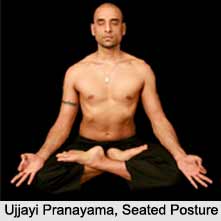 ‘Pranayama’ in Sanskrit is a yoga breathing exercise essential to develop a deep and thorough yoga practice. Amongst the wide varieties of Pranayama that are popular throughout India, the ‘Ujjayi Pranayama’ is a prominent one. Pranayama is one of the classical Eight Limbs of Yoga, according to the ‘Yoga Sutras’, the ancient yoga text compiled by the sage Patanjali. There are about 70 types of Pranayama mentioned in the traditional texts. These breathing techniques in addition to deepening the yoga practice, calm and invigorate the body and the spirit, benefiting life of the mat. The Ujjayi Pranayama is one such exercise that calms the mind and warms the body. The technique involves breathing deeply through the nose, slightly contracting the throat and filling the lungs completely. It is widely used in Ashtanga and Vinyasa yoga practices. In the Ashtanga yoga, Ujjayi Pranayama is mentioned as the archetypal yoga breathing practice of controlling ‘prana’, the life force, through paused breath.
‘Pranayama’ in Sanskrit is a yoga breathing exercise essential to develop a deep and thorough yoga practice. Amongst the wide varieties of Pranayama that are popular throughout India, the ‘Ujjayi Pranayama’ is a prominent one. Pranayama is one of the classical Eight Limbs of Yoga, according to the ‘Yoga Sutras’, the ancient yoga text compiled by the sage Patanjali. There are about 70 types of Pranayama mentioned in the traditional texts. These breathing techniques in addition to deepening the yoga practice, calm and invigorate the body and the spirit, benefiting life of the mat. The Ujjayi Pranayama is one such exercise that calms the mind and warms the body. The technique involves breathing deeply through the nose, slightly contracting the throat and filling the lungs completely. It is widely used in Ashtanga and Vinyasa yoga practices. In the Ashtanga yoga, Ujjayi Pranayama is mentioned as the archetypal yoga breathing practice of controlling ‘prana’, the life force, through paused breath.Etymology of Ujjayi Pranayama
The word ‘Ujjayi’ is a concoction of Sanskrit words 'ud' and 'jayi' which together mean "to be victorious" or "to conquer". ‘Pranayama’ is formed by two words ‘prana’ which means life force, particularly breath, and ‘ayama’, which refers to extend or draw out, thus signifying extension of breath. Quite ideally therefore, in Ujjayi Pranayama, the lungs of the practitioner are fully expanded as that of a mighty conqueror. It is also often referred to as "victorious breath." Given the sound it makes when performed correctly, this breath is also sometimes called the "ocean breath" or "hissing breath". Many yoga teachers simply refer to it as "Ujjayi breath".
Technique of Ujjayi Pranayama
Ujjayi Pranayama is a diaphragmatic breathing technique, first filling the lower belly, activating the first and second ‘chakras’ (energy points or nodes in a subtle body, one of a series of psycho-spiritual elements of living beings), rising to the lower rib cage to activate the third and fourth ‘chakras’ and finally up to the upper chest and throat. Unlike some other forms of Pranayama, the Ujjayi breath is typically performed with ‘asana’ (the place and posture while practising yoga) practice. The distinct exercise aids in stretching the breath whilst warming it, by prior letting it into the lungs and therefore heating the body. The 3 breathing techniques of ‘Puraka’, ‘Kumbhaka’ and ‘Rechaka’ form the wholesome process of Ujjayi Pranayama.
Puraka: The process of single inhalation has been termed as Puraka. In Ujjayi Pranayama, Puraka is therefore the act of inhalation through the nose, where the "ocean sound" is created by moving the glottis as air passes in. As the throat passage is narrowed and thus, so is the airway, the passage of air through which creates a hissing sound.
Kumbhaka: In Pranayama, Kumbhaka stands for a particular breathing technique. The apt process of suspension and retention of breath is the key element in Kumbhaka, performed while inhalation, termed as ‘Antara Kumbhaka’ (retaining the air after slightly forceful inhalation, thus filling the lungs with more air than normal) as well as exhalation, termed as ‘Bahya Kumbhaka’ (suspending the breath after exhaling more air than normal).
For more, visit the link below: